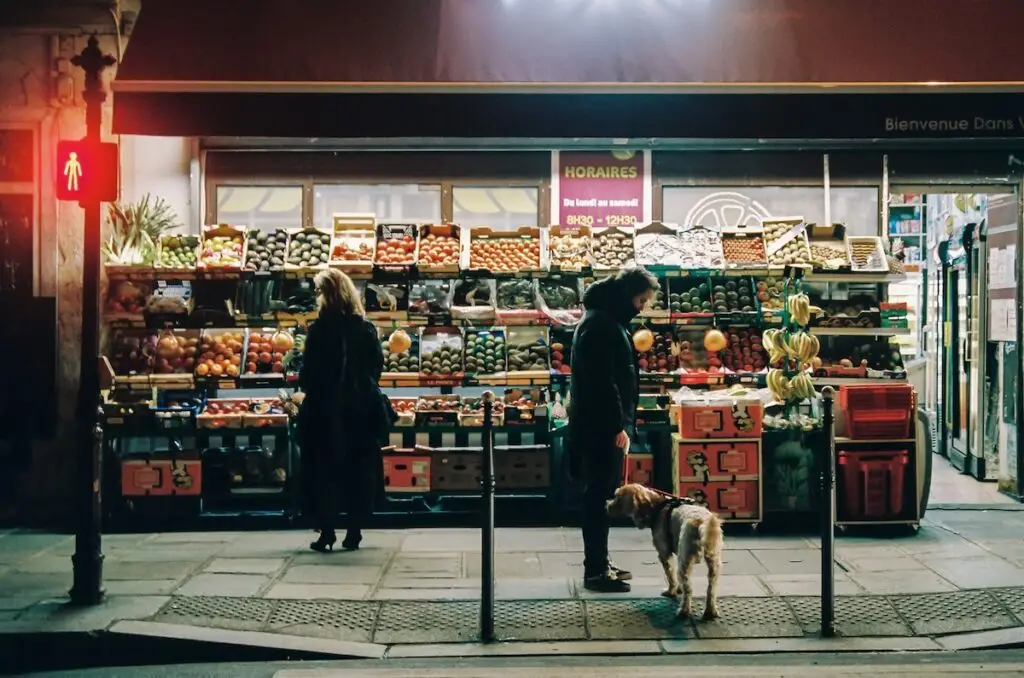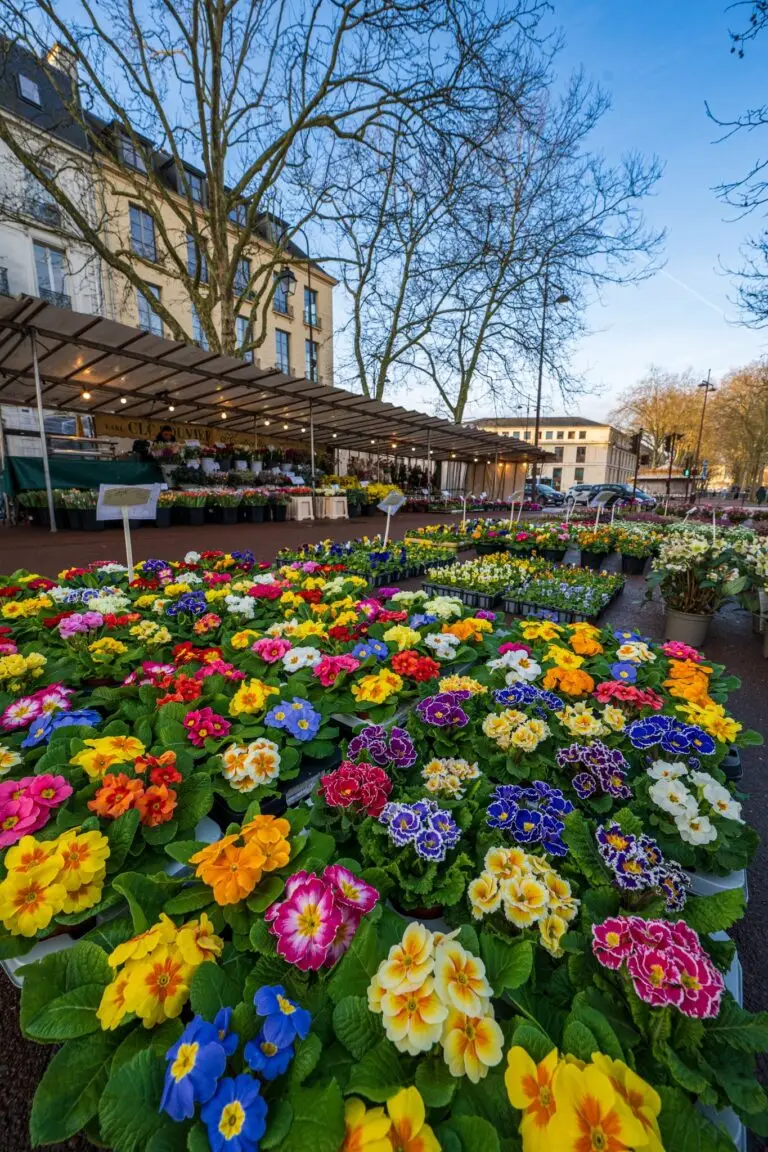Did you know that the average French person spends about 13% of their household budget on food, compared to just 6% in the United States?
That statistic shocked me when I first moved to France. I quickly realized that grocery shopping here wasn’t just about grabbing food—it’s practically a cultural institution. Those first few months navigating French supermarkets were equal parts thrilling and terrifying. I’ve been that confused expat staring blankly at cheese selections that seem to require a doctoral degree to understand.
But don’t worry! After years of trial and error (and some embarrassing language mix-ups), I’ve compiled everything you need to know about grocery shopping in France. Trust me, you’ll be shopping like a local in no time!
Types of Grocery Stores in France
When I first arrived in France, I made the rookie mistake of assuming all grocery stores were created equal. But I was so wrong: France has a whole ecosystem of food shopping options, each with their own purpose.
The hypermarché (hypermarket) is the French equivalent of a Walmart Supercenter, but with way better food. Chains like Carrefour, E.Leclerc, and Auchan are massive one-stop shops where you can buy everything from fresh baguettes to bed sheets. I remember getting completely lost in my first Carrefour visit—the place was bigger than my entire apartment complex! These megastores typically sit outside city centers and offer the widest selection at competitive prices.
The supermarché (supermarket) is your standard mid-sized grocery store, similar to what you might be used to back home. Chains like Monoprix, Casino, and Super U are found in most neighborhoods. My local Monoprix became my go-to spot for weekly shopping. It’s large enough to have variety but small enough that I don’t need a map and compass to navigate the aisles!
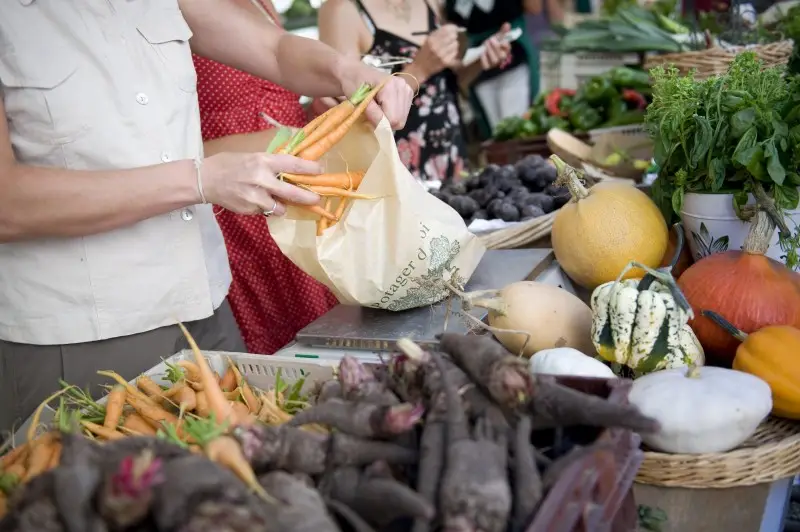
Then there’s the marché (open-air market), which quickly became my Sunday morning ritual. Nothing beats strolling through stalls of farm-fresh produce while sipping coffee and practicing my still-terrible French with the vendors. I’ve found the quality at these markets to be exceptional, though prices can be higher than in supermarkets. My favorite market memory? When I accidentally asked for “poisson” (fish) instead of “poison” (poison) to kill garden pests. The fishmonger’s face was priceless!
For quick needs, there’s the épicerie or supérette (convenience store). My corner Franprix saved me countless times when I realized at 9 PM that I was out of milk or wine (equally essential in France). These small shops charge a premium for convenience but are lifesavers in urban areas.
Lastly, don’t overlook the specialty shops: the boulangerie (bakery), boucherie (butcher), fromagerie (cheese shop), and so on. Yeah, it’s less convenient than one-stop shopping, but the quality difference is remarkable. My local fromager actually remembers my preferences and always has recommendations. Try getting that at a hypermarket!
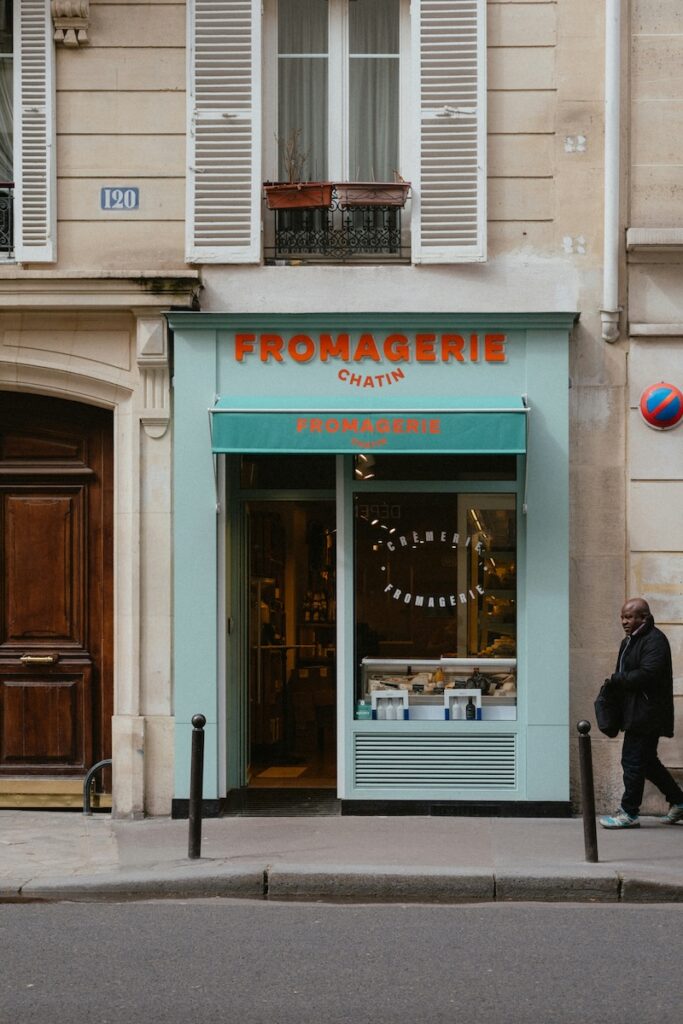
Navigating French Supermarkets
The layout of French supermarkets threw me for a loop at first. While American stores often place essentials like milk and eggs at opposite ends to maximize your walking path (sneaky marketing!), French stores are typically organized by food categories in a more logical flow.
The produce section (les fruits et légumes) usually greets you first, and you’ll notice two big differences from American stores. First, you’ll need to weigh and price-tag your own selections in most stores. I learned this the embarrassing way when I held up an entire checkout line my first week! Look for the scales in the produce area, place your items on them, select the corresponding picture or code number, and stick the printed price label on your bag.
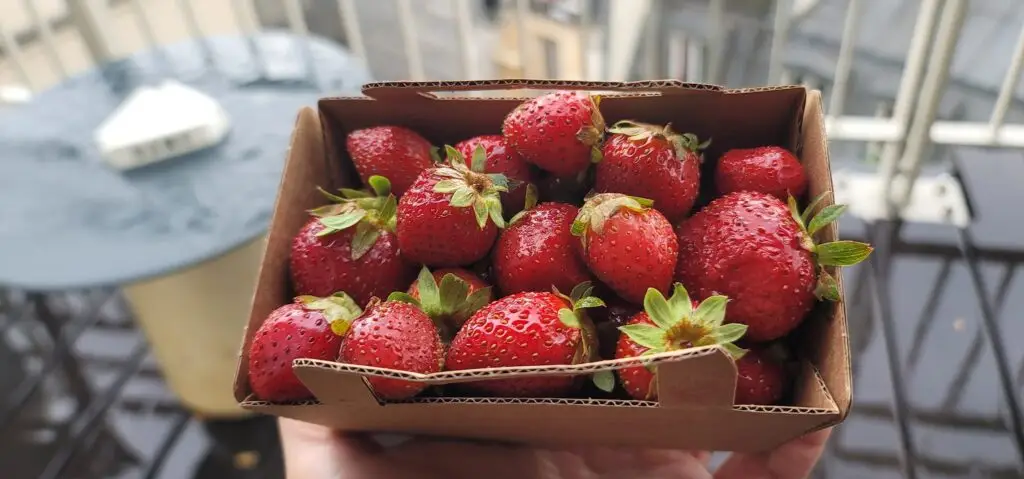
The bread section (la boulangerie) is almost always staffed, even in supermarkets. Don’t grab that baguette yourself—point and ask, or you might get the stink-eye from both staff and fellow shoppers.
The cheese section (le rayon fromage) can be utterly overwhelming. After all, France produces over 1,500 distinct types of cheese. I spent my first year pointing randomly and hoping for the best. Now I know to ask for recommendations based on whether I want something pour le petit déjeuner (for breakfast), pour le plateau (for a cheese board), or pour cuisiner (for cooking).
The wine section (le rayon vin) is equally intimidating but typically organized by region rather than grape variety. Don’t be fooled into thinking you need to spend a fortune—there are excellent wines under 10€.
My strategy? I started by trying one wine from each major region to discover my preferences. Bordeaux reds remain my favorite, but I’ve developed an unexpected appreciation for Loire Valley whites!

Understanding French Food Labels and Terminology
French food labels contain a wealth of information once you know what to look for. The most important quality indicators include:
- AOC/AOP (Appellation d’Origine Contrôlée/Protégée): Products with strictly controlled origin and production methods. Worth the premium price!
- Label Rouge: Superior quality standard, particularly for poultry and meat.
- AB (Agriculture Biologique): The organic certification in France.
- Sans OGM: Non-GMO products.
Don’t look for eggs of milk in the refrigerated sections. French don’t always put these things in the cold. Some essential vocabulary that saved me:
- Frais: Fresh
- Surgelé: Frozen
- Entier/Demi-écrémé/Écrémé: Whole/Semi-skimmed/Skimmed (for milk)
- De ferme: Farm-raised
- Fait maison: Homemade
- DLC (Date Limite de Consommation): Use-by date
One confusing aspect of French dairy is understanding the different cream options. I once attempted to make whipped cream with “crème fraîche” only to discover it doesn’t whip well! For whipping, you need “crème entière liquide” or “crème fleurette.” “Crème fraîche épaisse” is more like American sour cream.
Seasonal Shopping and Local Specialties
One thing I love about shopping in France is the strong emphasis on seasonal eating. Supermarkets and especially markets prominently feature whatever is in season, and prices reflect this natural cycle.
Spring brings amazing asparagus and strawberries. Summer offers an explosion of tomatoes, zucchini, and stone fruits. Fall is all about mushrooms, apples, and pears. Winter showcases root vegetables, citrus, and hearty greens. The difference in flavor between in-season and out-of-season produce is remarkable—I’ll never forget my first perfectly ripe French summer peach after years of eating tasteless winter imports in the States.
Each region also has its specialties that you’ll find prominently displayed in local stores. In Brittany, you’ll find the best butter and seafood. In Alsace, look for choucroute (sauerkraut) and delicious charcuterie. The Mediterranean coast offers incredible olive oils and herbs.
I’ve made it a personal mission to explore regional specialties wherever I travel in France!
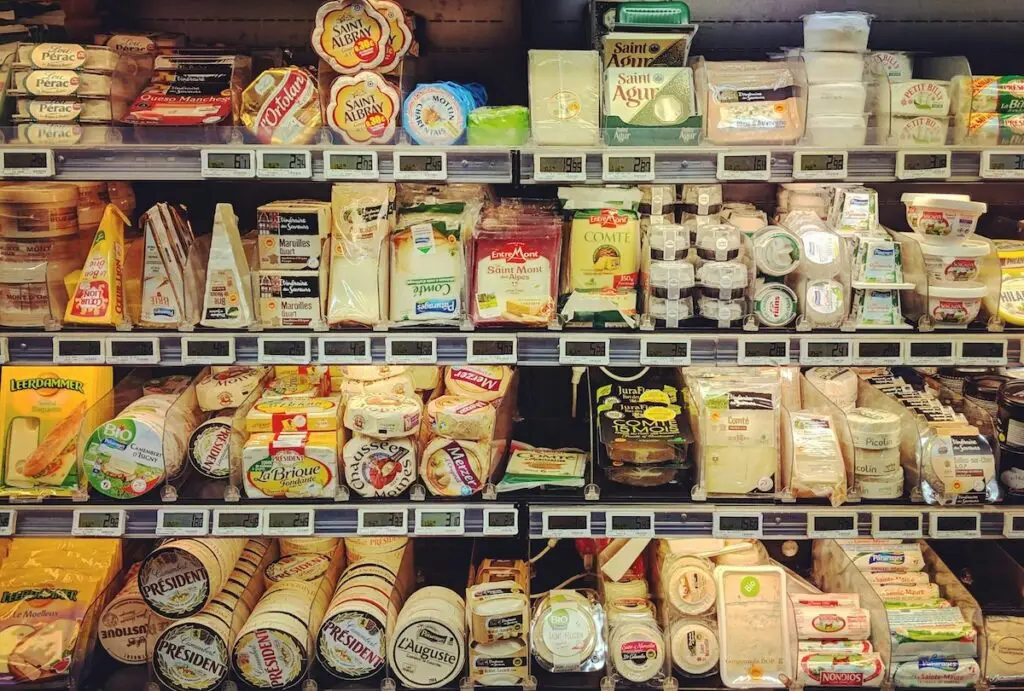
Money-Saving Tips for French Grocery Shopping
Grocery shopping in France can be expensive, especially if you’re used to American prices for certain items. However, I’ve developed some strategies to keep costs reasonable:
Shop at discount chains like Lidl and Aldi for basics. The quality is surprisingly good, especially for pantry staples. I buy my cleaning supplies, basic pasta, and canned goods at Lidl, saving about 30% compared to regular supermarkets.
Take advantage of loyalty programs (programmes de fidélité). Most major chains offer cards that provide discounts and accumulate points. My Carrefour card has saved me hundreds of euros over the years.
Look for “premier prix” or “marque repère” items—these are store brands that offer good value. Not all are created equal, though! Through trial and error, I’ve found that store-brand dairy and basic baking ingredients are usually fine, while cleaning products and coffee are worth the extra for name brands.
Shop late for discounts on perishables. Many stores mark down bread and prepared foods in the evening. I’ve scored freshly made quiches and salads at half price by shopping an hour before closing.
Watch for the “promotions” signs and seasonal sales. French supermarkets frequently run specials, particularly on wine. I’ve built up a decent wine collection by buying during promotions and storing bottles for later.
The biggest money-saver? Adapt to French eating habits! When I first arrived, I tried recreating my American diet and nearly went broke buying imported peanut butter and breakfast cereals.
Once I switched to a more French approach—simple breakfasts, cooking with seasonal ingredients, and treating meat as the main event—my grocery bills dropped dramatically.
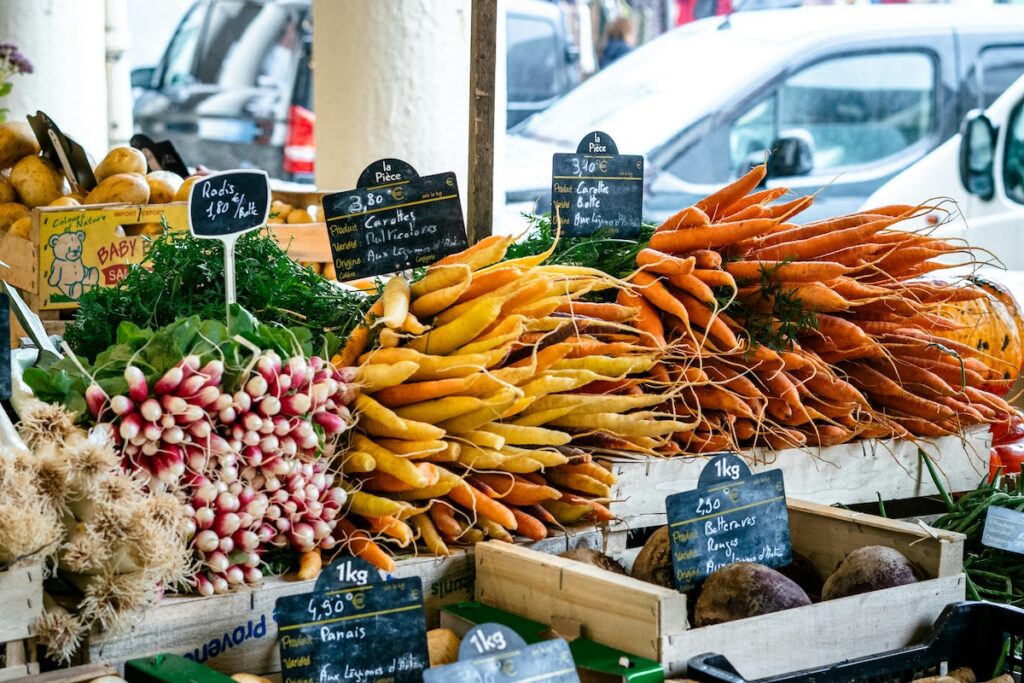
Cultural Etiquette in French Grocery Stores
Shopping in France comes with unwritten rules that took me a while to figure out. Save yourself the dirty looks I received and remember these tips:
Always greet shop staff with “Bonjour” when entering small stores or approaching service counters. This isn’t optional; I once had a cheese vendor deliberately ignore me until I properly greeted him. Lesson learned.
Bring your own bags. France has been ahead of the curve on reducing plastic waste, and most stores charge for bags. I keep a folding tote in my purse at all times after having to juggle loose groceries home one too many times.
Prepare to bag your own groceries at checkout. Unlike in America, baggers aren’t common in French supermarkets. The cashier will scan your items with lightning speed, and you’re expected to keep up with bagging. My first time, I stood there waiting for someone to bag my groceries while a line of irritated French shoppers formed behind me!
Don’t touch fruits and vegetables with bare hands if you’re not buying them. As mentioned earlier, use the provided gloves or small bags.
Keep your voice down. Americans (like me) tend to speak louder than is customary in France. I noticed people staring at me in stores before I realized my “normal” volume was considered disruptively loud here.
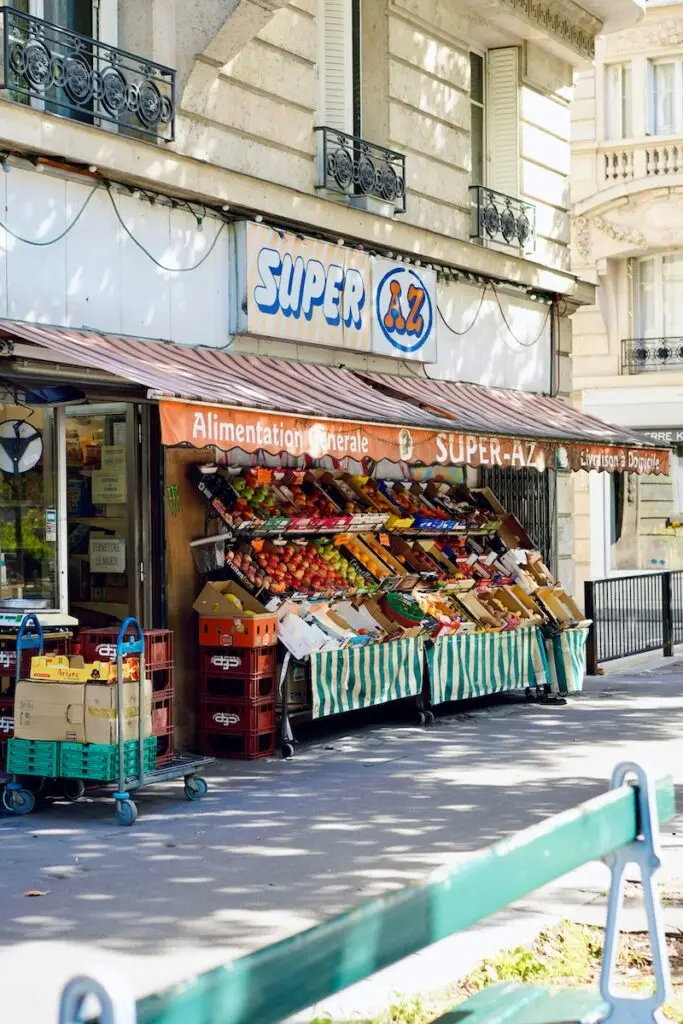
Grocery Stores in France: Conclusion
Grocery shopping in France has gone from being an intimidating chore to one of my favorite parts of expat life. There’s something deeply satisfying about mastering the local food landscape and being able to navigate it confidently. The emphasis on fresh, seasonal ingredients has completely transformed how I think about food and cooking.
My advice to new expats? Embrace the learning curve. Yes, you’ll make mistakes (like my infamous “fish vs. poison” mix-up), but each one brings you closer to feeling at home. Start with a hypermarket to get your bearings, then gradually explore markets and specialty shops as your confidence grows.
À bientôt et bon appétit!
